Your cart is currently empty!
Author: admin

Concern over rising garment imports from Bangladesh
A huge jump in duty-free garment imports from Bangladesh under the free trade agreement has put the domestic industry in a fix. This comes amidst slowing domestic demand and banks curtailing credit to 80 per cent of MSMEs (micro, small and medium enterprises) in the sector.
Import of garments from Bangladesh was up 82 per cent to $365 million last fiscal. It has been growing steadily at a CAGR (compounded annual growth rate) of 52 per cent and is expected to touch $3.6 billion by 2024-25. This will render about 10 lakh people jobless with most of the small garment industry shutting shop.
Bangladesh, which has signed an FTA with both India and China, has been sourcing fabric duty-free from China and exporting garments to India, thus providing a back-door entry for Chinese fabrics into the country.
Ironically, export of garments from India to Bangladesh attract a duty of 125 per cent, said Rahul Mehta, President, Clothing Manufacturers Association of India, at an event to announce the launch of the 69th National Garment Fair between July 15 and 18 in Mumbai.
The government should ensure that Bangladesh sources a part of its fabrics requirement from India as putting a cap on their export looks difficult, he said.
The association expects business transactions worth ₹800 crore with the participation of 1,000 brands, 899 stores and 45,000 retailers in the fair.
Premal Udani, former Chairman, Apparel Export Promotion Council, said Bangladesh’s garment export was at $3 billion in 2005 and India’s was at $5 billion, but today their exports have touched $36 billion while India is struggling at $16.5 billion.
Vietnam, which was not even counted among the top exporters then, has recorded garment export of $24 billion last year, he said.
Instead of announcing piecemeal policy measures, he said the government should come out with stated policy for the next five years to boost exports. This will help manufacturers plan their expansion and achieve scale, he said.
For the first time ever, garment exports had fallen by four per cent to $16.1 billion last fiscal, against $16.7 billion logged in 2017-18, Udani said. However, exports have revived partially in the last two months with the government’s export incentive schemes.
On the Union Budget, Mehta said the Finance Minister has hinted at special sourcing concessions for foreign-owned single- and multibrand but details are not yet out.
It will be a big blow if the government eases the current mandatory 30 per cent domestic sourcing norm, he said.
A Bloomberg report adds: Bangladesh which is the world’s second-largest garment exporter, has seen the value of its overseas sales rise to a record $40.5 billion in the year ended June 30, coinciding with US President Trump boosting tariffs on $200 billion of Chinese goods to 25 per cent from 10 per cent. The US-China trade war has seen American and Chinese orders for more than half of the 1,981 tariffed products so far being rerouted to other countries, including Vietnam and Malaysia.
For Bangladesh, which aims to double total exports to $72 billion by 2024, snaring part of the $41 billion of the clothing business that goes to China will provide a fillip to an economy that the Asian Development Bank forecasts will expand a record 8 per cent for the next two years.
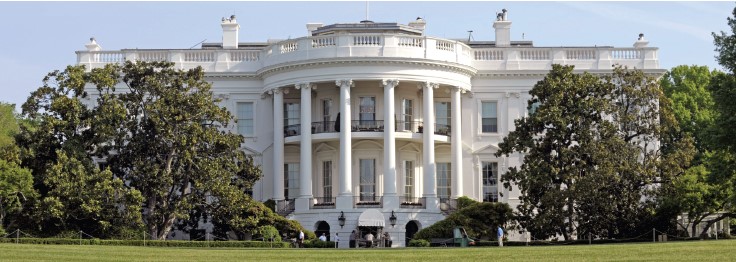
US drags India to WTO over duty hike on American goods
The US dragged India to the WTO by filing a complaint against New Delhi’s move to increase customs duties on 28 American goods, alleging the decision is inconsistent with the global trade norms. According to a communication of the Geneva based World Trade Organisation (WTO), the US said that the additional duties imposed by India “appears to nullify or impair the benefits accruing to the US directly or indirectly” under the GATT 1994.
The General Agreement on Tariffs and Trade (GATT) is a WTO pact, signed by all member countries of the multi-lateral body, aims to promote trade by reducing or eliminating trade barriers like customs duties.
The US has alleged that the duties imposed by India appears to be inconsistent with two norms of GATT.
The US has stated that India does not impose these duties on like products originating in the territory of any other WTO member nation.
“India also appears to be applying rates of duty to US imports greater than the rates of duty set out in India’s schedule of concessions,” the communication said quoting the US application.
The duties are inconsistent because “India fails to extend to products of the US an advantage, favour, privilege or immunity granted by India with respect to customs duties and charges of any kind imposed on or in connection with the importation of products originating in the territory of other members…,” the US has alleged.
As part of the dispute, the US has sought consultations with India under the aegis of the WTO’s dispute settlement mechanism.
“We look forward to receiving your reply to the present request and to fixing a mutually convenient date to hold consultations,” it said.
As per the WTO’s dispute settlement process, the request for consultations is the first step in a dispute. Consultations give the parties an opportunity to discuss the matter and find a satisfactory solution without proceeding further with litigation.
After 60 days, if consultations fail to resolve the dispute, the complainant may request adjudication by a panel.
This case assumes significance as officials of both the countries would be meeting next week here to discuss trade related issues.
The two countries are also at loggerheads at the WTO on other issues. The US has challenged certain export promotion schemes of India, while India has challenged USA’s unilateral hike on customs duties on certain steel and aluminium products.
The US has rolled back export incentives from India under its GSP programme and New Delhi has imposed higher customs duties on 28 American products including almond, pulses, walnut, chickpeas, boric acid and binders for foundry moulds.
The other products on which duties were hiked include certain kind of nuts, iron and steel products, apples, pears, flat rolled products of stainless steel, other alloy steel, tube and pipe fittings, and screws, bolts and rivets.
The duties were hiked as retaliation to the US move to impose the highest customs duties on certain steel and aluminium goods.
India’s exports to the US in 2017- 18 stood at USD 47.9 billion, while imports were at USD 26.7 billion. The trade balance is in favour of India.

India Inches Towards A RCEP Deal
The RCEP, India most-ambitious trade pact, is currently under negotiation. It includes the 10-nation bloc of the Association of Southeast Asian Nations (ASEAN) and their six free-trade partners — China, India, Japan, South Korea, Australia and New Zealand. The countries working towards finalizing RCEP comprise a quarter of global gross domestic product, 30% of global trade, 26% of foreign direct investment flows, and 45% of the world’s population.
“Engagement with ASEAN is at the core of India’s ‘Act East’ policy. ASEAN is the gateway to the Indian Ocean region and as close partners, there is convergence of views in India’s and ASEAN’s outlook in the region,”.
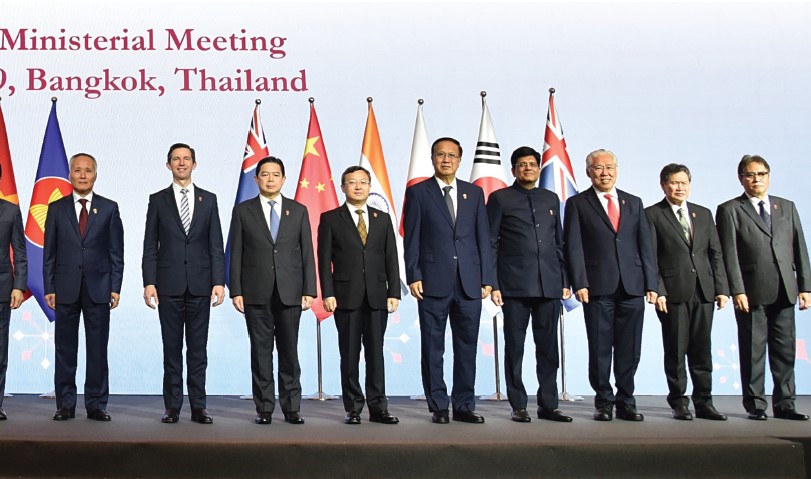
India’s bilateral trade jumped threefold from $21 billion in 2005-06 to $96.7 billion in 2018-19. ASEAN countries together have emerged as the largest trading partner of India in 2018-19 (followed by the US), with a share of 11.47 per cent in India’s overall trade, while India was ASEAN’s sixth largest trading partner in 2018.
Investment flows are also substantial both ways. The foreign direct investment (FDI) inflows into India from ASEAN in the April-March 2018- 19 period was about $16.41 billion which is approximately 36.98 per cent of total FDI flow into India.FDI inflows from India to ASEAN in 2018 was $1.7 billion, placing India as ASEAN’s sixth largest source of FDI.
Commerce and Industry Minister Piyush Goyal is representing India at the Trade Ministers’ meeting of member countries of the Regional Comprehensive Economic Partnership (RCEP) in Bangkok and the East Asia Economic Ministers Summit in Bangkok between September 8-10.The Minister is also scheduled to hold bilateral meetings with his counterparts from Japan, Singapore, China, Indonesia, Australia, New Zealand, the Philippines, Thailand and Russia, according to an official release.“The meetings will be attended by Economic Ministers and senior leaders of the 10 ASEAN member countries and eight East Asia Summit (EAS) countries,” according to an official release.The Trade
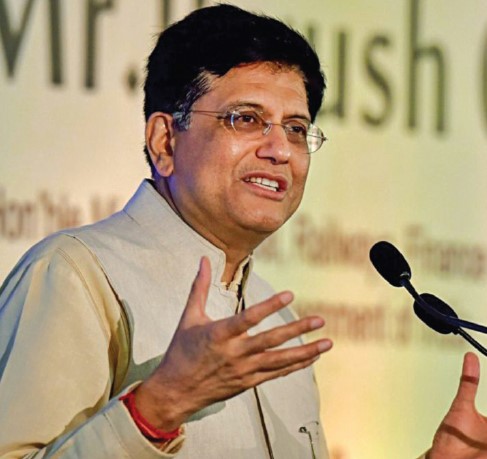
Ministers of RCEP countries, which includes the 10-member ASEAN, India, China, South Korea, Japan, Australia and New Zealand, will try to give a final shape to the proposed free trade pact which includes several areas such as goods, services, investments, intellectual property and government procurement.
Twenty-eight rounds of talks have concluded, apart from eight ministerlevel meetings.The RCEP meet in Bangkok this month is aimed at closing a mega trade deal that has been in the works since 2012. The Bangkok meet this month hopes to narrow differences in the deal that has been in the making since 2012.
India’s Commerce Minister Piyush Goyal did not attend a ministerial meet in China last month against the backdrop of Indian concerns of cheaper imports from China overwhelming India’s manufacturing sector, if India joins the grouping. India’s trade deficit with China in 2018 was more than $60 billion.Representatives of iron and steel, dairy, textiles, marine products, electronics, chemicals, pharmaceuticals and plastic industries have been the most vocal against the trade deal.There is a general feeling that India’s trade agreements have not worked out well.
The first point of objection with the RCEP is that India’s trade deficits have always widened with nations after signing free-trade-agreements (FTAs) with them. The same is true for India’s FTAs with the ASEAN, Japan, Korea, and Singapore, most of which are RCEP nations. So far, the rise in Indian trade deficit with its FTA partners has occurred due to cheap imports of final products that have led to an increase in consumer surplus (or consumer well-being), but adding to the angst of the domestic producers.
The second point of contention lies with exposing vulnerable sectors to market forces and the vagaries of competition emerging from global trade. Even after more than quarter of a century of economic reforms, Indian manufacturing are yet to mature to be competitive enough to face the vagaries of competition brought about by international trade.
Under such circumstances, the Indian industry is hardly in a position to compete in a level playing ground in a free-trade region. “Make in India” is meant to create enabling conditions for both domestic and foreign businesses to thrive. If domestic industry has to thrive,
it needs protection as also the enabling conditions created by factor and product market reforms. Megatrade deals like the RCEP may derail the timing and coordination of such plans.
The country is also not in any mega trade pact that includes China, which is a part of RCEP. There is concern that Chinese imports will become a bigger problem if a deal is signed. Aware of its massive trade deficit, India is preparing a final list of products on which it may retain import tariffs for China in the proposed Regional Comprehensive Economic Partnership (RCEP) agreement, said official sources.
The government has been preparing such a list for a while now, based on its plan of a “differential tariff reduction”. China, which has benefited the least, has opposed this move, along with richer economies such as Australia and New Zealand.“Considering our sensitivity to imports from China, this has been the case throughout,” said a senior government official, who did not want to be named, adding: “An extensive list is being prepared.”He also said the list was unfinished and was being drawn up after extensive consultation with domestic industry.
Sources also said India had suggested a mechanism to fix an import ceiling, again particularly for China. This is the first time New Delhi will fix such a ceiling in any trade deal. Government officials did not confirm this, but they said similar proposals had been opposed by other nations before. Earlier, India had agreed to reduce tariffs on 76 per cent of all items for all nations, apart from special measures for China. Others had demanded New Delhi open up at least 90 per cent of all items.
Currently, it is broadly accepted the RCEP will lead to tariffs being eliminated on 28 per cent of the traded goods to begin with. This will be followed by 35 per cent of all products being eliminated in phases.
Officials also said the final deal would necessarily include all negotiating countries. India had been on the receiving end of repeated questions by other nations on whether it is serious about signing the deal. Senior leaders of Asean, including Malaysian Prime Minister Mahathir Bin Mohamad, had said the mega Asia-Pacific deal could be negotiated without India “for the time being”. Senior diplomatic sources of other nations confirmed that commitments to reduce tariffs were now dependent on individual nations. This may result in each nation setting a specific tariff reduction for each of the rest.
The government has also dismissed the idea of an “early harvest” approach to the RCEP talks. If this approach was adopted, it would mean the agreement would be signed after some issues had been agreed upon, while others would be resolved eventually.
The current stance is a shift from India’s earlier position of adopting a “package of early deliverables” created by the trade-negotiating committee of the RCEP. Australia’s lead trade negotiator James Baxter has said the last ministerial meet in Bangkok saw all negotiating trade ministers unanimously decided to complete the negotiations in full by November, seven years after the talks started.
“As long as India’s domestic industry and our national interests is protected, the faster it (RCEP) is done, the better it is for India,” Commerce and Industry Minister Piyush Goyal, has said.
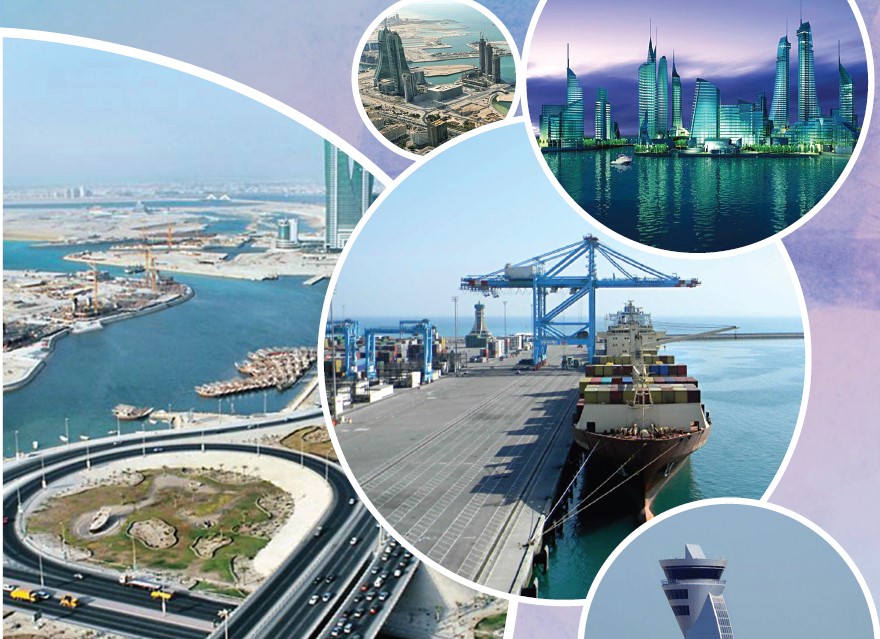
Special Economic Zone (SEZ)…Simplified
SEZs are popular instruments in developing countries for pursuing export-led growth strategies, for easier integration into the world economy. The main advantage of SEZs can be summarised as promotion of industrialisation and economic growth through sustainable development.
WHAT CONSTITUTES a Special Economic Zone (SEZ) is determined individually by each country. According to the World Bank definition in 2008, a modern day SEZ typically includes “a geographically limited area, usually physically secured (fenced-in); single management or administration; eligibility for benefits based upon physical location within the zone; separate customs area (duty-free benefits) and streamlined procedures.” In an SEZ, business and trade laws relating to export and import are different (read, more liberal) as compared to other parts of the country.
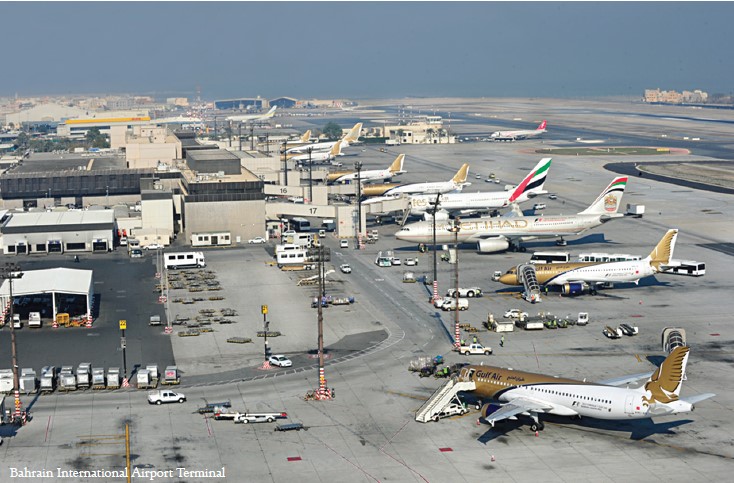
An SEZ is projected as a duty-free area for the purpose of trade, operations, duty, and tariffs. This demarcated zone is considered to be a place outside the country’s national borders for all tax purposes. Thus, SEZs are like a separate island within the territory of a particular country. SEZs are located within a country’s national borders, and their aims include increased trade balance, employment, increased investment, job creation and effective administration. To encourage businesses to set up in the zone, financial policies are introduced. These policies typically encompass investing, taxation, trading, quotas, customs and labour regulations. Additionally, companies may be offered tax holidays, where upon establishing themselves in a zone, they are granted a period of lower taxation.
Most countries (including India) have specific laws for their SEZs. As per law, SEZ units are deemed to be outside the customs territory of the host country. Goods and services coming into SEZs from the Domestic Tariff Area (DTA) are treated as exports from that country and goods and services rendered from the SEZ to the DTA are treated as imports into that country. Within SEZs, units may be set-up for the manufacture of goods and other activities including processing, assembling, trading, repairing, reconditioning, etc.
The creation of SEZs by the host country may be motivated by the desire to attract Foreign Direct Investment (FDI). The benefits a company gains by being in a Special Economic Zone may mean that it can produce and trade goods at a lower price, aimed at being globally competitive.
Since Special Economic Zones cover a broad range of more specific zone types, the World Bank created a table to clarify distinctions between types of SEZs. These include Free Trade Zones (FTZ), Export Processing Zones (EPZ), Free Zones (FZ) / Free Economic Zones (FEZ), Industrial Estates (IE), Free Ports and Urban Enterprise Zones (UEZ) among others.
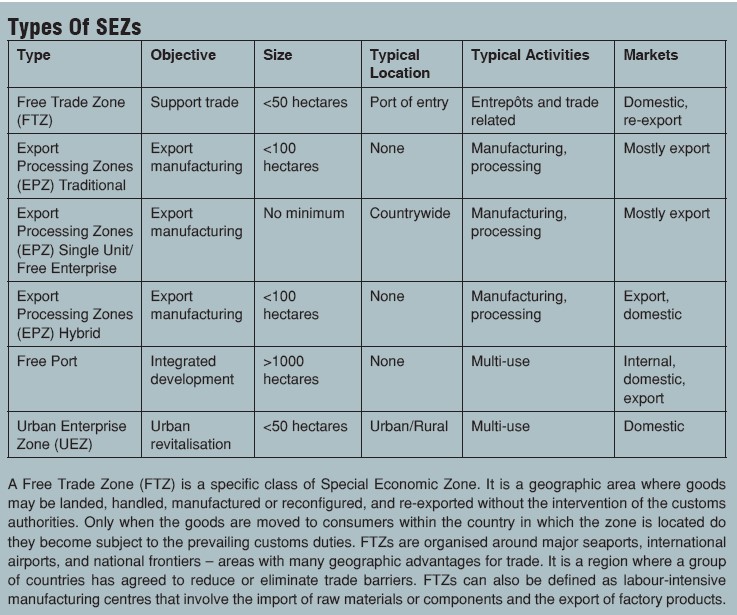
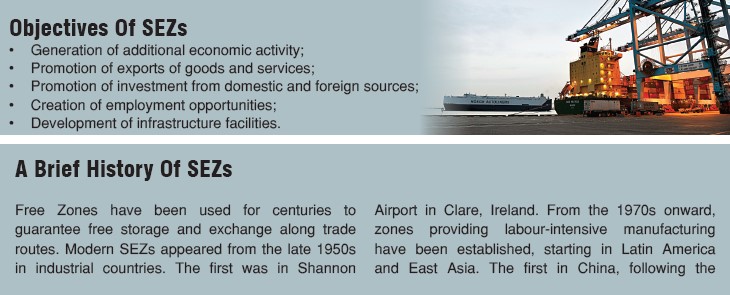
opening of China in 1979 by Deng Xiaoping, was the Shenzhen Special Economic Zone, which encouraged foreign investment and simultaneously accelerated industrialisation in this region. These zones attracted investment from multinational corporations. Following this example, SEZs have been established in several countries including India, Pakistan, Poland, Russia, Kazakhstan and the Philippines.
Several countries in the West Asia, North Africa and the Middle East were early adopters of free zones. Jordan, Israel, Syria, Iran, and Egypt, for example, established governmentrun zones in the 1960s and 1970s.
The majority of zones in the Middle East and North Africa region are Free Trade Zones, aimed at facilitating trade with their host countries. Though many of these zones permit manufacturing, trading and associated activities (for instance, packaging and repackaging, breakbulk) remain predominant. With a handful of exceptions, the economic contribution of zones in the Middle East has been negligible compared to zone programmes in the Far East and Latin America, largely due to their traditional focus on trading activities rather than manufacturing. The notable exceptions to this are zones in Egypt and Jordan, which have developed a manufacturing focus. Enterprises in the Qualified Industrial Zones (QIZs) in Jordan, for example, are engaged in apparel assembly operations for the US market.
The government-developed Jebel Ali Free Zone in Dubai, a major regional distribution and logistics hub, has become an important development model in the region. Its success has spawned an increasing number of similar zone developments in the Gulf, not just within the other Emirates, but also in Oman and Bahrain. Dubai has also taken the lead in developing new, specialised zones, including both Internet City and Media City, which promote exports in IT and media-related services. A $3.3 billion large-scale offshore financial services zone and commodities market is being developed on Saadiyat Island, AbuDhabi.
SEZs In India
The Special Economic Zone (SEZ) policy in India first came into inception on April 1, 2000. The prime objective was to enhance foreign investment and provide an internationally competitive and hassle free environment for exports. The idea was to promote exports from the country and realising the need that level playing field must be made available to the domestic enterprises and manufacturers to be competitive globally.
SEZs were introduced to India in 2000, following the already successful SEZ model used in China. Prior to their introduction, India relied on Export Processing Zones (EPZs) which failed to make an impact on foreign investors. By 2005, all EPZs had been converted to SEZs. As of 2017, there are 221 SEZs in operation, with a further 194 approved for 2018. For developers to establish an SEZ in India, applications can be made to the Indian Board of Approval. Companies, partner firms, and individuals may also apply by completing Form-A which is available on the Department of Commerce’s website. There are four types of SEZs in India, which are categorised according to size: Multi-sector (1,000+ hectares); Sector-specific (100+ hectares); Free Trade & Warehousing Zone (FTWZ) (40+ hectares); and Tech, handicraft, non-conventional energy, gems & jewellery (10+ hectares).
INCENTIVES & FACILITIES
The incentives and facilities available to SEZ developers include:
- Exemption from customs/excise duties for development of SEZs for authorised operations approved by the BOA.
- Income Tax exemption on income derived from the business of development of the SEZ in a block of 10 years in 15 years under Section 80-IAB of the Income Tax Act.
- Exemption from minimum alternate tax under Section 115 JB of the Income Tax Act.
- Exemption from dividend distribution tax under Section 115O of the Income Tax Act.
- Exemption from Central Sales Tax (CST).
- Exemption from Service Tax (Section 7, 26 and Second Schedule of the SEZ Act).
There were about 143 SEZs (as of June 2012) operating throughout India, by February 2016 this had risen to 187. 634 SEZs have been approved for implementation by the Government of India (as of June 2012).
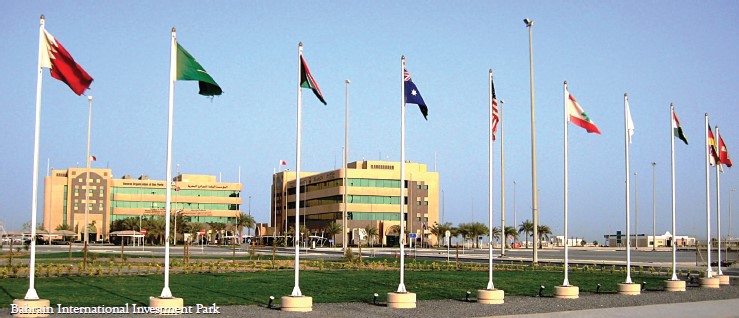
Bahrain’s FTZs Connecting Lives
With purpose-built infrastructure, specialised facilities, separate rules & regulations, exclusive connectivity to ports and other major industrial areas through multi-modal transport systems, Bahrain’s Free Trade Zones offer a competitive edge for foreign businesses operating out of here, contends Ivor Vaz
THE KINGDOM OF BAHRAIN is diversifying its economy away from unsustainable hydrocarbons resources to sectors such as banking and finance, trade and industry, retail and tourism. Its only physical link to Saudi Arabia via the King Fahd Causeway, constructed in 1986, has been a major contributor to inter-Gulf trade, tourism and retail. In terms of passenger traffic, the causeway is one of the busiest in the Middle East, with recorded traffic statistics of over 20 million passengers and 10 million vehicles in both directions each year.
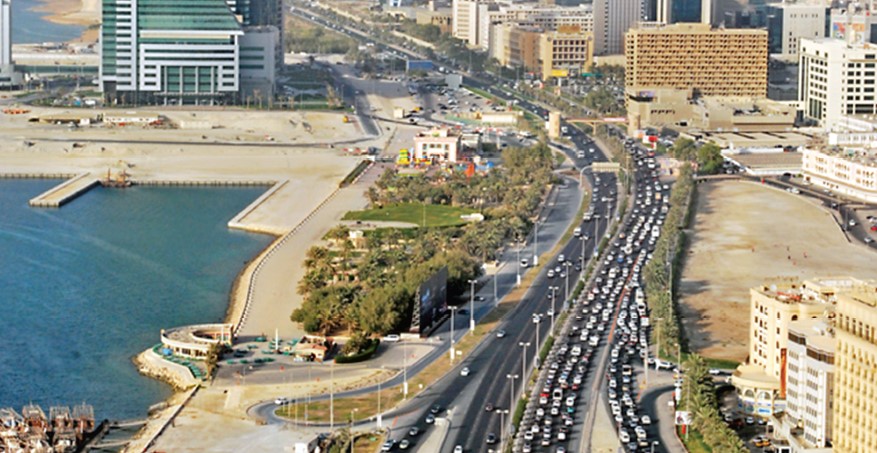
With its world-class infrastructure, excellent connectivity, low operating costs and business-friendly laws, the island nation today attracts foreign direct investment by allowing businesses and companies to operate in the country while offering various incentives and tax-friendly policies.
In 2013, Bahrain was ranked as the 12th most-free economy in the world by the US Heritage Foundation think tank, making it the only Middle East and North Africa country to appear in the Top 20. Bahrain is home to three Special Economic Zones (SEZs), all of which were ranked in the Top 20 locations for inward investment, economic development and business expansion in FDI Magazine’s ‘Global Free Zones of the Future’report.
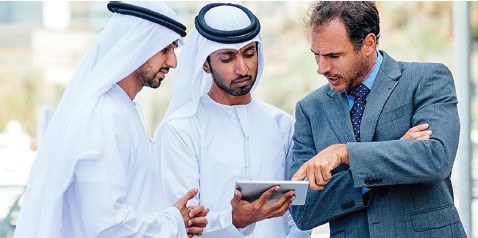
Bahrain has three central Free Trade Zones (FTZs):
Bahrain International Investment Park (BIIP), Bahrain Logistics Zone (BLZ), and Bahrain Airport Zone (BIA). Each FTZ offers a competitive edge for the foreign businesses operating in it with specialised infrastructure, worldclass facilities, exclusive regulations and rules, excellent multi-modal connectivity through sea, land & air to most of the Middle East & North African (MENA) markets, and offers a world-class environment for the businesses and companies to operate in the zone. The Free Trade Zones are predominately used for import, export, logistics and material processing.
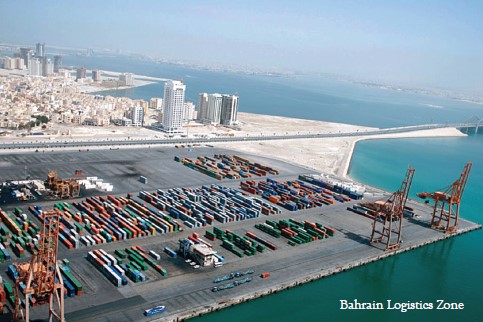
Bahrain Logistics Zone (BLZ) Operated by Ports and Maritime Affairs (PMA) at the Ministry of Transportation and Telecommunication, the Bahrain Logistics Zone (BLZ) is a regional trans-shipment hub with highlyintegrated logistics, purposebuilt Infrastructure, large-scale berthing facilities and plot entry allowances, designed explicitly for handling container truck traffic and freight-forwarding operations while remaining as the dedicated customs- free zone and value-added logistics park in Bahrain. The port zone, which was launched in the year 2008, is close to the biggest port of Bahrain, Khalifa bin Salman Port (KBSP) and is located in the heart of Salman Industrial City in Al Hidd Industrial Area. It offers land plots of 3,000 sq. metres and more for lease. The 100-hectare zone focuses on third-party logistics, storage and distribution (for export and re-export), as well as other logistics services and activities.
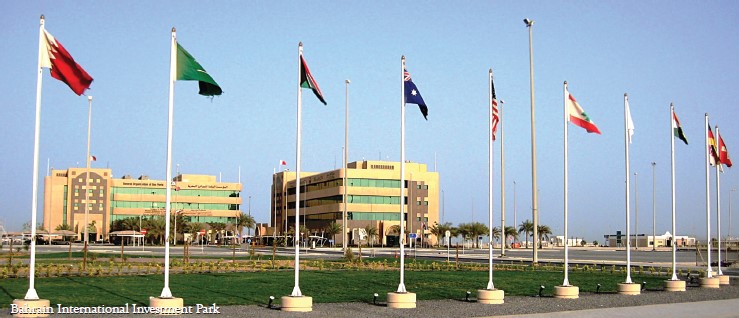
Facilities
- Plots of land start at 3,000 sq. metres, while the zone itself covers 100 hectares.
- Expansion plans announced, including the construction of a new 66kV power station.
Benefits
- Customs-free zone
- 100 per cent foreign company ownership
- Land, sea and air access
Industries
- Third-party logistics
- Storage and distribution
- Logistics services and valueadded logistics services, including assembly
Bahrain International Investment Park (BIIP)
Located in the Salman Industrial City, Muharraq Island, the Bahrain International Investment Park (BIIP) is strategically positioned on the north coast of Bahrain, taking only a five minutes’ drive from the Bahrain Logistics Zone (BLZ) and ten minutes from the Khalifa bin Salman Port.
BIIP offers 100 per cent foreign ownership of companies, duty-free access to GCC markets, exemption from import duties on both raw materials and equipment and 100 per cent repatriation of capital. Located 5 kilometres from Bahrain
International Airport, BIIP consists of 2.5 million sq. metres of leasable land, costing $1.33 a sq. metres a year to rent.
The BIIP is not a considered a free zone according to the law as the businesses & companies located in the area are considered to operate from Bahrain mainland which is within the GCC market empowering them with seamless cross-border access with a regional promotion of their products and services. This is considered as an advantage as the foreign companies operating out this zone avails the benefits as such it is operating in a free zone and also the advantages of duty-free cross-border operations across the GCC since the company is located in Bahrain.
Facilities
- 2.5 million sq. metres of prime land, located close to Bahrain International Airport and Khalifa bin Salman port. Benefits
- 100 per cent foreign ownership
- Zero corporate tax, guaranteed for 10 years
- Exemption from import duties on raw materials and equipment
- Duty-free access to all GCC markets, including Bahrain
- Free-trade access to the US
- 100 per cent repatriation of capital
- No minimum capital requirements
- No recruitment restrictions for first five years Industries
- Manufacturing
- International services
Bahrain International Airport (BIA) The Bahrain International Airport (BIA) serves as a driver of economic growth in the region by offering topnotch airport facilities and modern air logistics. It was established in 1927 as the first airport serving the Kingdom of Bahrain and currently operates as a significant aviation hub in the region. It currently serves as the Gulf Air’s central hub of operations. In addition to this, the airport continually upgrades the facilities and services with the latest technology to make the existing airport into a world-class facility, with best-in-class customer service which is in line with the Kingdom’s long-term Bahrain Economic Vision 2030 and maintaining its reputation as a leading financial, cultural and aviation centre in the Middle East.
Bahrain International Airport (BIA) sits in 19th place in the Free Zones of the Future list, and is ranked the 5th best Airport Zone in the world. Offering cargo facilities, offices and retail space, the foreign trade zone has no customs duties. It is governed by Mumtalakat, the government vehicle for Bahrain’s non-oil and gas investments, established in June 2006 by royal decree.
While BIA is not a free zone, infrastructure plans are in their final stages, including a possible free zone. Currently, as with most airports, BIA has a bonded cargo terminal, which allows importers to delay the payment of duty until products leave the facility.
Facilities
- Cargo facilities at BIA are located in a 19,000 sq. metres terminal providing export cargo sales, trans-shipment facilities, breakbulk cargo handling, dangerous goods provisions, customs clearance. Benefits
- Bonded cargo terminal Industries • Cargo facilities
- Retail
- Advertising space
- Offices
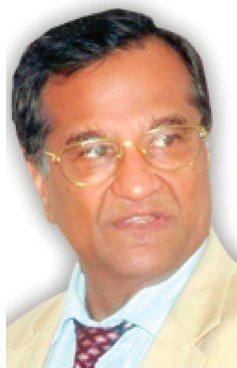
Govt announces booster for exports
Welcoming the much-needed booster for the exports sector, FIEO President, Mr Sharad Kumar Saraf said that the announcement made by the Hon’ble Finance Minister Ms Nirmala Sitharaman has come at a time when there are signs of worsening global economic conditions pointing further toward downward revision of global trade growth. Slew of new measures announced for the exports sector in the form of incentives & refund of taxes, export finance, export facilitation, free trade agreements, engineering and handicrafts will not only go a long way in enhancing the growth prospects of the sector in the short-term but will also give it a much needed boost in the medium-term and long-term and will stimulate the overall economy added Mr Saraf.
FIEO Chief said that the new scheme of Remission of Duties or Taxes on Export Products (RoDTEP) with revenue burden of up to Rs 50,000 crores for the government, will completely replace all Merchandise Exports from India Scheme (MEIS) from January 1, 2020 with the expectation that the new scheme will more than adequately incentivize the exporters than the existing schemes put together. The new scheme looks attractive as it will neutralise all duties and levies suffered by the export products. Giving three months lead time till 31st December to the existing MEIS will remove the uncertainty creeping in the minds of the exporters and will greatly help to finalise their export orders, Mr Saraf said. Further fully electronic refund module for quick and automated refund of ITC by September, 2019 will help the exporting community in not only speedy and timely refund of their GST but will also help them in getting their long pending refund of their ITC thereby mitigating their working capital requirements, said Mr Sharad Kumar Saraf.
Mr Saraf stated that besides measures taken to improve credit outflows from banks and transmission of interest rate cuts being effected by banks will go a long way in improving the cost and availability of credit, as the flow of credit to this sector has been under pressure since long. Expanding the scope of Export Credit Insurance Scheme (ESIC) by ECGC will enable reduction in overall cost of export credit including interest rates especially for MSMEs. Announcement on the revised Priority Sector Lending (PSL) norms for export credit, will release an additional ?36,000 crore to ?68,000 crore as export credit along with an active monitoring by an interministerial working group in the Department of Commerce, tracked through a dashboard will also help in keeping track of the overall export financing for the sector added FIEO Chief.
Mr Sharad Kumar Saraf also said that leveraging technology to reduce turnaround time at ports and airports through seamless digitization process of export clearances is also a welcome step, which will further reduce transaction cost and time. Holding of annual mega shopping festivals like Dubai Shopping Festival to will not only boost exports but will also help in creating value for Brand India products from labour-intensive sectors like Gems & Jewellery, Handicrafts, Yoga, Tourism and Textiles.
President FIEO said that online “Original Management System” for exporters will enable them to obtain Certificates of Origin, which is further expected to improve ease of doing business for exporters. Time-bound adoption of mandatory technical standards will not only elevate quality and performance, enhance competitiveness and address issue of sub-standard imports but will also give boost to Indian products overcoming nontariff barriers. Besides initiative on affordable testing and certification infrastructure will reduce cost of adoption of standards and certification for meeting international standards under different FTAs. And last but not the least, FIEO Chief is of the view that announcement on the FTA utilization mission headed by senior officials from Department of Commerce will be set up and will work with FIEO and other export houses to utilize concessional tariff in each FTA. The initiative which was one of the demands of the Federation will be able to enhance awareness of preferential duty benefits MSMEs and disseminate and facilitate compliance requirements under FTAs for both importers and exporters.
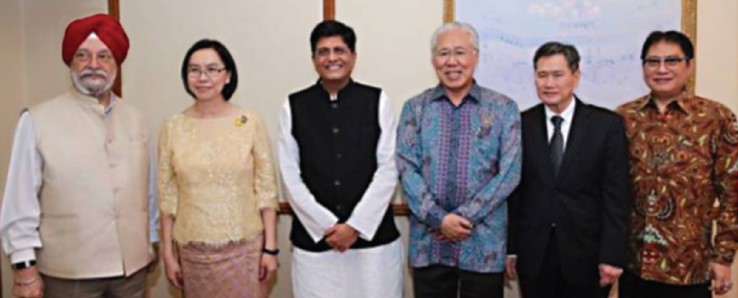
ASEAN persuades India to speed up talks on RCEP
Oct-Nov-Dec | 2019 OPEN TRADE TRADE ASEAN persuades India to speed up talks on RCEP Pressure is piling up on India from other members of the Regional Comprehensive Economic Partnership (RCEP), especially the ASEAN, to end its stalemate with China on market opening offered under the proposed pact.
Trade Ministers of Thailand and Indonesia and the Secretary-General of the 10-member ASEAN group met Commerce and Industry Minister Piyush Goyal in New Delhi on Tuesday to discuss ways to speed up the negotiations so that the pact is in place by the year-end, a government official told BusinessLine.
The RCEP, comprising 16 members, including the ASEAN, China, India, South Korea, Japan, Australia and New Zealand, was expected to be signed last year. Things, however, got delayed for a number of reasons such as India’s reluctance to offer substantial market access to China, disagreement between members over services offers and new governments in some countries like Malaysia.
“The troika from ASEAN countries that met Goyal was focussed on finding ways to move ahead in the negotiations so that the RCEP gets implemented in 2019. The visitors were told that while India would do its best in fast-tracking its discussions with other members, including China, it couldn’t ignore the interests of its industry,” the official said.
The Indian manufacturing sector including steel, engineering goods and automobiles, in its discussion with the Commerce Ministry recently, demanded that India should not offer zero duties on more than 42 per cent of traded items to China as most domestic producers will not be able to handle the increased competition.
However, New Delhi has already tentatively offered to eliminate duties on 74 per cent items from China (and also New Zealand and Australia) as part of the RCEP deal.
What has brought things to a standstill between India and China is Beijing’s demand that New Delhi should eliminate duties on more than 90 per cent items from the country, as it is willing to do in case of the ASEAN, Japan and South Korea, and is not ready to accept a lower offer.
“There will possibly be discussions between Indian and Chinese officials in a bid to break the deadlock over market access prior to the next round of RCEP talks in China later in July and the meeting of Trade Ministers in the country early August,” the official said.
China has already hinted that other members should go ahead with a mega trade pact if India continued to dilly-dally by proposing a free trade pact between ASEAN + 3 which includes China, South Korea and Japan.
New Delhi is hesitant about opting out of the RCEP pact because, if concluded, it would be the largest free trade bloc in the world accounting for 25 per cent of global GDP and 30 per cent of world trade, giving members huge opportunities to expand trade and investment within the region.

Trade point planned at India-China LAC
The Indian Army has approved the opening of a new trading point with China at Dumchelle in Ladakh, the third such along India’s disputed, albeit peaceful 3,488-km border with China in a confidence building measure ahead of Chinese President Xi Jinping’s October visit.
Although the Indian Army’s spokesperson did not respond to queries, three officials familiar with the matter said on condition of anonymity that the army has cleared the opening of the post, and that it is up to the government now.
The Trading post could open as soon as the end of the year and that work has already started on the customs check point and the road to it. The only thing left is for the Cabinet Committee on Security to sign off.
Dumchelle is in Southern Ladakh, and is strategically located between Chushul , one of the five designated Border Personnel Meeting (BPM) meeting points between the Indian and Chinese armies, and Demchok in Southern Ladakh.
The two other recognised trading points with China are Lipulekh in Uttrakhand and Nathu La in Sikkim. Predetermined, locally made items are traded through these points with an aim of boosting the local economy.
President Xi is scheduled to be in India in October for an informal summit with Prime Minister Narendra Modi. Opening up another trading point along the disputed Line of Actual Control (LAC) would be a major confidence building measure, analysts said.
Although the Dumchelle trading point will be new, trade at the border town between residents of Ladakh and the Tibetans from the other side has a long history. Goods are bought and sold at Dumchelle regularly. In addition, there is a three-week-long fair at Dumchelle where locals from both sides participate.
In the past, the Chinese People’s Liberation Army (PLA) has even used the hotline, which connects military commanders on both sides of the border and which is used to sort out minor issues, to discuss dates of the fair. “It is an informal arrangement between the two sides,” a senior serving Indian Army officer said.
“It is a traditional trade route. In the past, the army has written to the government advising it to either completely stop the trade or formalise the exchange,” a government official added.
The current trade through Dumchelle is informal and designating it a trading point will automatically lead to “supervision of the goods flowing through this area. Also, there could be revenue implications for the government,” this person said. “Ladakh is flooded with Chinese made goods, much of which is traded through this particular point.”
India-China ties which hit a low during the 73-day long stand-off between the armies of the two countries in the Doklam plateau in Sikkim in 2017 warmed after the historic informal summit at Wuhan between Prime Minister Modi and President Xi in April 2018. Both leaders agreed to give “strategic” guidance to the respective militaries to reduce border tensions.
Nonetheless, caution on either side is understandable. The LAC is not demarcated. To address this, the two countries have agreed to elaborate mechanism that includes banner drills and communication between local commanders through established “hotlines” to ensure minor issues do not escalate into major ones.

Roundtable Reflections on Indo–US ‘Trade Irritants’ India-Russia A Time-Tested Partnership
Relations between India and Russia are rooted in history, mutual trust and mutually beneficial cooperation. This is a strategic partnership that has withstood the test of time, and which enjoys the support of the people of both countries, says Ivor Vaz
IF THERE HAS EVER BEEN a longstanding and time-tested partner for India, it is Russia. The development of India-Russia relations has been a key pillar of India’s foreign policy. Since the signing of ‘Declaration on the India-Russia Strategic Partnership’ in October 2000 (during the visit of Russian President Vladimir Putin to India), India-Russia ties have acquired a qualitatively new character with enhanced levels of cooperation in almost all areas of the bilateral relationship including political, security, trade and economy, defence, science and technology, and culture. Under the Strategic Partnership, several institutionalised dialogue mechanisms operate at both political and official levels to ensure regular interaction and follow up on cooperation activities. During the visit of the Russian President to India in December 2010, the Strategic Partnership was elevated to the level of a ‘Special and Privileged Strategic Partnership’.
Political Relations Annual Summit: The Annual Summit meeting between the Prime Minister of India and the President of the Russian Federation is the highest institutionalised dialogue mechanism in the strategic partnership between India and Russia. So far 17 Annual Summit meetings have taken place alternatively in India and Russia. Russian President Vladimir Putin visited Goa from 15-16 October 2016 for the 17th Annual Summit, which resulted in 19 documents related to cooperation in defence, space, information security, foreign policy, trade & investment, hydrocarbons, shipbuilding, railways, and science and technology. Indian Prime Minister Narendra Modi and Putin also adopted a Joint Statement ‘Partnership for Global Peace and Stability’ and a ‘Roadmap of Events’ to celebrate the 70th anniversary of the establishment of the diplomatic relations between India and Russia in the year 2017. Earlier, the two leaders held a bilateral meeting on the sidelines of the SCO Summit in Tashkent (Uzbekistan) on 24 June 2016. Modi visited Russia in June 2017 for the 18th Annual Summit, which took place in St. Petersburg and resulted in the conclusion of 12 documents related to cooperation over a very wide range of activities. The 18th Summit also witnessed the adoption of the ‘St. Petersburg Declaration’ which not only highlights the multi-faceted cooperation between the two countries but also provides a comprehensive matrix for future cooperation. During this visit, Modi had a separate meeting with governors of sixteen Russian regions where they discussed various aspects related to the enhancement of cooperation between Indian and Russian regions. He also participated in the St. Petersburg International Economic Forum as the Guest of Honour. Subsequently, Modi and Putin also met at the sidelines of Astana SCO summit in June 2017 and G20 Summit in Hamburg in July 2017.
Intergovernmental Commissions: There is regular high-level interaction between the two countries. Two Inter-Governmental Commissions – one on Trade, Economic, Scientific, Technological and Cultural Cooperation (IRIGC-TEC), cochaired by the Indian External Affairs Minister (EAM) and the Russian Deputy Prime Minister (DPM); and another on Military Technical Cooperation (IRIGC-MTC), cochaired by the Russian and Indian Defence Ministers – meet annually. The Inter-Governmental Commission on Military Technical Cooperation (IRIGC-MTC) co-chaired by the two Defence Ministers and its Working Groups and Sub-Groups review defence cooperation between the two countries. Russian Defence Minister Sergei Shoigu visited New Delhi for the 16th Session of the IRIGC-MTC on 26 October 2016. The 17th Meeting of IRIGC-MTC took place in Moscow on June 23, 2017. Indian Defence Minister Arun Jaitely co-chaired this meeting with Shoigu. Russian Deputy Prime Minister Dmitry Rogozin visited India in September 2016 to co-chair the 22nd session of the IRIGC-TEC with the Indian External Affairs Minister. In 2017, Rogozin visited India for the meeting of Co-Chairs of IRIGC-TEC on May 10, 2017.
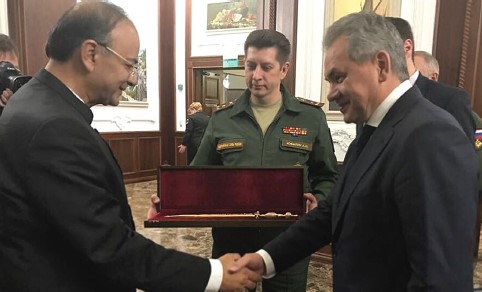
Bilateral Interaction: Rogozin visited India on 20 August 2016. He called on PM Modi and also met the National Security Advisor Ajit Doval during this visit. Rogozin subsequently led a large Russian delegation to the Vibrant Gujarat Summit in January 2017. Doval visited Russia on January 30-31, 2017 and met the Secretary of the Security Council of the Russian Federation, Nikolai Patrushev. They discussed issues of mutual bilateral, regional and global interest, with special focus on security and defence cooperation. India’s Foreign Secretary visited Russia for Foreign Office Consultations on March 16-17, 2017. Deputy NSA visited Russia in March 2017 and met his counterpart for the 17th India- Russia Joint Coordination Group Meeting. He also attended the 4th International Arctic Forum Meeting in Arkhangelsk. Russian Minister for Industry and Trade, Denis Manturov, visited India in March 2017. He jointly inaugurated the International Engineering Sourcing Show 2017 with CIM in Chennai. He later attended the first-ever India- Russia Military Industrial Conference in Delhi on March 17-18, 2017. Russia’s Deputy Prime Minister Yury Trutnev visited India in March 2017. He met the EAM in Delhi, and signed deals worth US $ 1.4 billion during his visit to Mumbai. The Russian side also signed a Term Sheet with TATA Power for developing a coal field in Kamchatka during this visit. Minister of Defence, Finance and Corporate Affairs of India, Arun Jaitley attended the 6th Moscow Conference on International Security on 25-26 April 2017. He also had a bilateral meeting with his Russian counterpart during this visit. He again visited Russia on 21-23 June 2017 and also co-chaired the first ever meeting of the India-Russia High- Level Committee on Science and Technology held in Novosibirsk. NSA Doval visited Russia in May 2017 to attend the 8th International Meeting of High Level Officials Responsible for Security Matters in Zavidovo. He also had a bilateral meeting with his Russian counterpart. R.N. Ravi, Chairman Joint Intelligence Committee, participated in a joint Anti-Terrorist Exercise of the competent Bodies of the Member States of the Shanghai Cooperation Organisation held in Yaroslavl from August 09-11, 2017. Earlier in 2016, the EAM held separate bilateral meetings with DPM Rogozin and Foreign Minister Sergey Lavrov on the sidelines of the 14th Russia- India-China (RIC) Foreign Ministers meeting in Moscow on 18 April 2016.
Speaker of Lok Sabha, Sumitra Mahajan, led a delegation of Members of Parliament of India to Russia for the 4th India-Russia Inter- Parliamentary Commission meeting on 11 July 2017. She met the Chairman of the State Duma (Lower House of the Russian Parliament), Vyacheslav Volodin, and the Chairperson of the Federation Council, Valentina Matvienko, in Moscow. She also addressed the Plenary Meeting of the State Duma in Moscow on 12 July 2017. Volodin visited India in February 2015 and participated in the 3rd Session of the India-Russia Inter-Parliamentary Commission. He also called on the President and Vice President of India. A five member delegation from the Russian Parliament attended the BRICS Womens’ Parliamentary Forum in August 2016. In April 2016, Minister of State for Defence visited Moscow and attended the 5th Moscow Conference on International Security. The Minister of Law and Justice participated in the St Petersburg International Legal Forum in May 2016. In June 2016, Minister of State for Petroleum & Natural Gas participated in the 16th St. Petersburg International Economic Forum (SPEIF), and also met his Russian counterpart. In March 2016, the Russian Minister for Emergency Situations co-chaired the first meeting of the India-Russia Joint Commission for cooperation in preventing emergency situations in New Delhi. A three-member team from NDRF visited Russia for orientation and training at the Russian Civil Defence Academy in April 2017. A number of other exchanges are being discussed in accordance with Joint Implementation Plan.

Consultations: Pursuant to the signing of the Protocol for Consultations between the Foreign Ministries, Secretary (West), Secretary (ER) and Secretary (East) visited Russia for bilateral consultations in 2016. Other official level consultations (Secretary/ Joint Secretary) on issues such as disarmament & non-proliferation, Central Asia, European issues, information security, South Asia, UN, BRICS, SCO and RIC were also held in 2016. During the 17th Annual Summit, the sides concluded a Protocol for Consultations between the foreign ministries for the period 2017-18. In 2017, a number of Consultations on issues such as disarmament and non-proliferation, information security, property issues, SCO and counter-terrorism have already taken place in accordance with the new plan.
Defence & Security Cooperation
India has longstanding and wideranging cooperation with Russia in the field of defence. India-Russia military technical cooperation has evolved from a buyer – seller framework to one involving joint research, development and production of advanced defence technologies and systems. BrahMos Missile System as well as the licensed production in India of SU-30 aircraft and T-90 tanks, are examples of such flagship cooperation. During the 17th Annual Summit, the sides concluded agreements on supply of S-400 air defence systems, construction of frigates under Project 1135.6 and shareholders agreement on the formation of joint venture to manufacture Ka-226T helicopters in India. The two countries also hold exchanges and training exercises between their armed forces annually. The joint military exercise ‘Indra 2016’ was held in the Ussuriysk District in Vladivostok from 22 September -02 October 2016. The annual bilateral naval exercise ‘Indra – Navy’ took place off the coast of Vishakhapatnam on 14-21 December 2016. Both sides have also decided to hold the first ever triservices exercised in the year 2017. A roadmap for the development of bilateral defence cooperation was signed during the 17th Meeting of the IRIGC-MTC.
Indian Air Chief Arup Raha visited Russia from 24-29 October 2016. Russian Naval Chief visited India in March 2017. The first ever India- Russia Military Conference took place in Delhi in March 2017. Nearly 45 Russian entities participated in this conference. FSB Director, Alexander Bortnikov led a ninemember delegation to India in March 2017 and called on the Minister of Home Affairs.
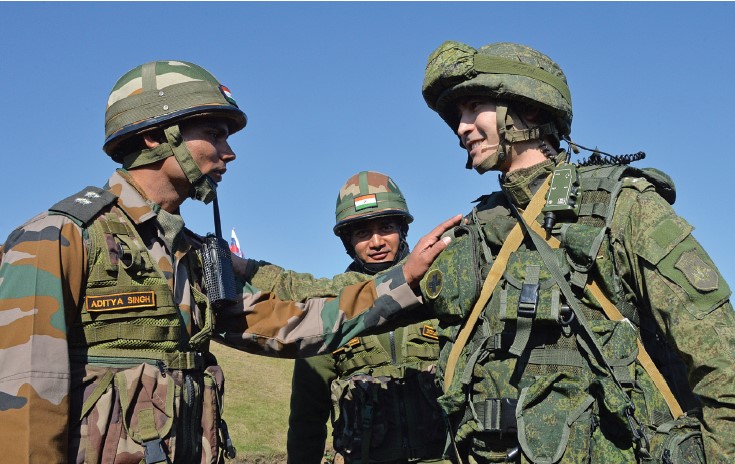
Economic Relations
Making the economic partnership a strong pillar of the bilateral partnership like other areas of cooperation between India and Russia is a key priority for both governments. In December 2014, the leaders of the two countries set a target of US$ 30 billion bilateral trade by 2025. According to Russian Federal Customs Service data, bilateral trade during in 2016 amounted to US$ 7.71 billion (decline of 1.5% over 2015), with Indian exports amounting to US$ 2.39 billion and imports from Russia amounting to US$ 5.32 billion. Major items of export from India include pharmaceuticals, tea, coffee and tobacco, machinery and mechanical appliances, organic chemicals, and electrical machinery and equipment. Major items of import from Russia include pearls, precious and semi-precious stones & metals, nuclear power equipment, electrical machinery and equipment, mineral oil & products, iron & steels, and optical, precision and surgical equipment. India and Russia are exploring various ways for enhancing bilateral trade. A few important steps/projects that could provide a major boost to bilateral trade are: Operationalisation of the ‘Green Corridor’ project between the two countries which has already reached an advanced stage; implementation of the International North- South Transport Corridor, and the signing of an FTA between Indian and the Eurasian Economic Union (EaEU). In December 2016, Eurasian Economic Union (EaEU) approved the decision to start negotiations between India and the EaEU for signing an FTA.
Indian investments in Russia are estimated to be about US$ 13 billion which include Vankorneft and Taas-Yuryakh Tass fields; Imperial Energy Tomsk; Sakhalin I; Volzhsky Abrasive Works Volgograd; and Commercial Indo bank. Russian investments in India total about US$ 16 billion, including the acquisition of the ESSAR Group, Kamaz Vectra in Hosur; Shyam Sistema Telecom Ltd, Sberbank and VTB. Earlier, both sides had expressed their desire to raise the level of investments in each other’s countries to US $ 15 billion (each way) by 2025. Based upon current figures it appears that the target will be achieved almost eight years earlier than planned.
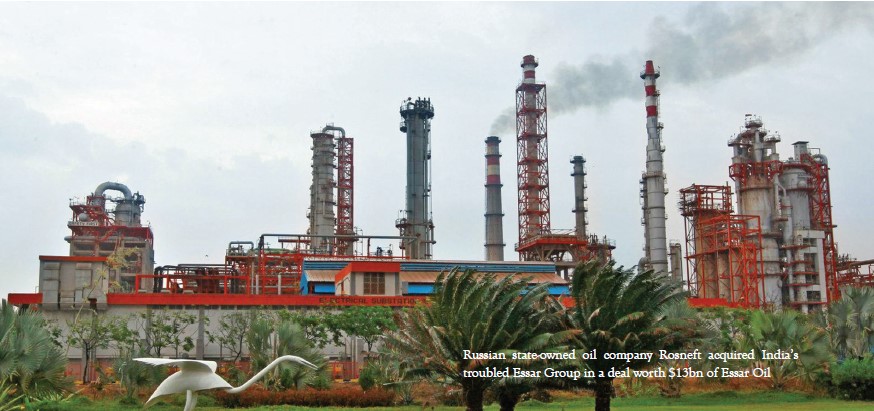
The Inter- Governmental Commission on Trade, Economic, Scientific, Technological and Cultural Cooperation (IRIGC-TEC) is the apex G2G forum to review economic cooperation. It reviews sectoral cooperation under working groups on trade and economic cooperation, priority investments, modernisation and industrial cooperation (subgroups on civil aviation, mining, fertiliser, and modernisation), outstanding issues, energy & energy efficiency, science and technology, communications & IT, tourism and culture, and sub-groups on banking & financial matters and on conservation of tigers & leopards. The 22nd Session of the IRIGCTEC was held in New Delhi on 13 September 2016, which was cochaired by India’s EAM and Russian Deputy Prime Minister Dmitry Rogozin. In 2017, Rogozin visited India for the meeting of Co-Chairs of IRIGC-TEC on May, 2017.
The India-Russia Forum on Trade and Investment co-chaired by the Commerce and Industry Minister of India and the Russian Minister for Economic Development, and India-Russia CEOs’ Council are the two primary mechanisms to promote direct bilateral businessto- business contacts between India and Russia. Mechanisms such as India-Russia Business Council (partnership between FICCI of India and CCI of Russia), India-Russia Trade, Investment and Technology Promotion Council (partnership between CII of India and RUIE of Russia), India-Russia Business Dialogue (partnership between CII of India and Russia’s Business Council for Cooperation with India) and India-Russia Chamber of Commerce (with focus on SMEs) supplement the efforts to build direct businessto- business ties. To promote smoother and greater movement of businessmen, the two countries signed a protocol on 24 December 2015 to simplify visa procedures for businessmen.

Hydrocarbons is an active area for exploring cooperation between the two countries. In the second and third quarter of 2016, Indian companies invested close to US$ 5.5 billion in Russia’s Oil and Gas sector, which included acquisition of 23.9% stake in Vankorneft and 29.9% in Taas-Yuryakh by an Indian Consortium of Indian Oil Corporation Limited (IOCL), Indian Oil Corporation Limited (OIL) and Bharat Petro Resources Limited (BPRL); and acquisition of 15% and 11% stake by ONGC Videsh Limited (OVL) in Vankorneft from Rosneft Oil Company of Russia. During the 17th Annual Summit, the sides concluded documents between Engineers India Ltd and Gazprom on the Joint Study of a gas pipeline to India and other possible areas of cooperation; Agreement in the area of Education and Training between ONGC Videsh Ltd and Rosneft Oil Company; and Programme of Cooperation (PoC) in the Field of Oil and Gas for the period 2017-18; and the Sale and Purchase Agreement between a Rosneft-led consortium and Essar for acquisition of 98% stake in Essar Oil Limited. The Rosneft led Consortium has invested close to US $ 13 billion in this deal. The sides are working towards realisation of an ‘Energy Bridge’ between the two countries, which is based on robust civil nuclear cooperation, LNG sourcing, partnership in the Oil and Gas sector, and engagement in renewable energy sources. Russia’s Deputy Energy Minster Yuri Sentyurin visited India from 27-28 June, 2017 to discuss the possibility of a gas pipeline between India and Russia.
In December 2015, Tata Power signed an agreement with the Russian Ministry of Far East Development for investment projects in energy sector in the region. In October 2016, Indian and Russian railways signed an agreement on high speed rails in India. In December 2015, Heavy Engineering Corporation (HEC), Ranchi concluded agreements with Russian company CNIITMASH on establishing a Centre of Excellence in India and modernisation of HEC’s facilities; and Solar Energy Corporation of India signed an MoU with Russian counterpart for constructing solar plants in India.
India participated in one of Russia’s of major flagship industrial exhibitions, ‘INNOPROM 2016’ in Ekaterinburg (Russia) from 11-14 July 2016 as a partner country, where the Indian delegation was led by Commerce and Industry Minister and the Chief Ministers of Andhra Pradesh, Maharashtra and Rajasthan. They also held a roundtable meeting with the Russian Prime Minister. An export Promotion Council delegation headed by Joint Director Mishikant Jumde, and another CII delegation headed by Srikumar Nair participated in INNOPROM-2017 from Indian side. Minister for Industry and Trade, Denis Manturov, led a large delegation to India and attended the opening ceremony of the BRICS Trade Fair, and met CIM in October 2016. He also met the CMs of Rajasthan, Andhra Pradesh, and Maharashtra.
Nuclear Energy
Russia is an important partner for India in the area of peaceful use of nuclear energy. It recognises India as a country with advanced nuclear technology with an impeccable nonproliferation record. In December 2014, Department of Atomic Energy (DAE) and Russia’s Rosatom signed the Strategic Vision for strengthening cooperation in peaceful uses of atomic energy between India and Russia. Kudankulam Nuclear Power Plant (KKNPP) is being built in India with Russian cooperation. KKNPP Units 1 and 2 have already become operational. PM Modi and President Putin jointly dedicated Units 1 & 2 to the nation on separate occasions through video conferencing. They also initiated the concrete pouring for Units 3 &4 through videoconference on October 15, 2016. An agreement on localisation of manufacturing of nuclear equipment in India was also concluded during the Annual Summit on 24 December 2015. The agreement for KKNPP Units 5 & 6 was concluded during the 18th Annual Bilateral Summit in St. Petersburg in June 2017.
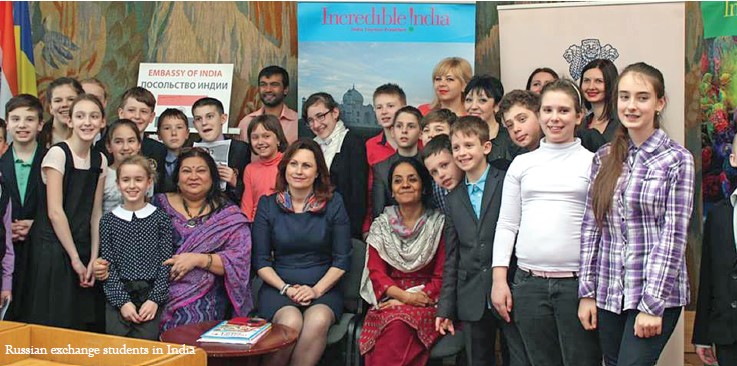
Space Cooperation
India-Russia cooperation in the field of peaceful uses of outer space dates back to about four decades. 2015 marked the 40th anniversary of the launch of India’s first satellite “Aryabhatt” on a Russian (then USSR) launch vehicle ‘Soyuz.’ In 2007, India and Russia signed a framework agreement on cooperation in the peaceful uses of outer space, including satellite launches, GLONASS navigation system, remote sensing and other societal applications of outer space. In June 2015, the space agencies signed an MoU on expansion of cooperation in the field of the exploration and use of outer space for peaceful purposes. An agreement was signed between C-DAC and GLONASS for cooperation in technologies based on satellite navigation. On 15 October 2016, ISRO and Roscosmos signed an MoU to establish ground measurement gathering stations for GLONASS and NAvIC in India and Russia. Both sides are also exploring the possibility of cooperation in manned space flight.
Science & Technology The Working Group on Science and Technology functioning under IRIGCTEC, the Integrated Long Term Programme (ILTP) and the Basic Science Cooperation Programme are the three main institutional mechanisms for bilateral Science and Technology cooperation, while the Science Academies of the two countries promote interacademy exchanges. ILTP during its 25-year long implementation period, supported over 500 joint R&D projects and setting up of 9 thematic centres in India and Russia that resulted in generation of over 1500 joint publications and many new products, processes, facilities, and research centres besides developing over 10,000 scientific contacts. India-Russia Science and Technology Centre with a branch each in Delhi-NCR and Moscow was set up in 2011-12 in order to promote two-way transfer of technologies and their commercialisation.
Two new Programmes of Cooperation in the field of Science, Technology, Innovation, and Biotechnology concluded in October 2013 have become active mechanisms for cooperation. These programmes have already supported the first batch of 11 joint R&D projects in 2014. In December 2014, Indian Council of Medical Research and Russian Foundation of Basic Research entered into an MoU for cooperation in health research. On 8 May 2015, Department of Science & Technology (DST) and Russian Science Foundation signed an agreement to support basic and exploratory research. During the 16th Annual Summit, C-DAC, IISc (Bangalore) and Moscow State University signed an agreement on cooperation in the field of high performance computing. During the 17th Summit, DST and FASO (Federal Agency for Scientific Organisation) signed an agreement for cooperation in the field of science and technology. A Basic Science Cooperation Programme between DST and the Russian Foundation for Basic Research has been working quite successfully from 2016-17. A number of new initiatives such as the Indi- Russia Bridge to Innovation, cooperation in telemedicine, creation of a Traditional Knowledge Digital Library, GIAN, and the Russia-India Network (RIN) of Universities are being promoted to encourage the growth of bilateral interaction in the field of S&T. Prof. Ashutosh Sharma, Secretary, Department of Science and Technology visited Russia from 19-21 June, 2017.
Cultural Cooperation
There is a strong tradition of Indian studies in Russia. Jawaharlal Nehru Cultural Centre at the Embassy of India, Moscow (JNCC) maintains close cooperation with leading Russian institutions, including the Institute of Philosophy (Moscow); Russian State University for Humanities (Moscow); Institute of Oriental Studies (Moscow); Institute of Asian and African Studies of the Moscow State University; School of International Relations of the St. Petersburg University; Institute of Oriental Manuscripts (St Petersburg); Peter the Great Museum of Anthropology & Ethnography (Kunstkamera) in St Petersburg; Far Eastern Federal University (Vladivostok);and Russian Institute for Cultural Research (Krasnodar). There is a Mahatma Gandhi Chair on Indian Philosophy in the Institute of Philosophy, Moscow. About 20 Russian Institutions, including leading universities and schools, regularly teach Hindi to about 1,500 Russian students. Apart from Hindi, languages such as Tamil, Marathi, Gujarati, Bengali, Urdu, Sanskrit and Pali are taught in Russian Institutions. There is strong interest among Russian people in Indian dance, music, yoga and Ayurveda. JNCC conducts classes in yoga, dance, music and Hindi for approximately 500 students every month.
There are regular cultural initiatives to promote people-to-people contacts between India and Russia, including reciprocal Years of Culture. The President of India inaugurated the Year of Indian Culture ‘Namaste Russia’ in Moscow on 10 May 2015. About 15 performances in eight cities were held as part of ‘Namaste Russia’ across various parts of Russia over 2015. The Embassy with support from regional governments organised week-long celebrations marking the third International Day of Yoga (IDY) covering 68 regions spanning 87 locations and involving over 37685 Yoga enthusiasts. During the previous Summit in October, the leaders adopted a ‘Roadmap of Events’ to celebrate the 70th anniversary of the establishment of the diplomatic relations between India and Russia with year-long celebrations in 2017 under which numerous events have already been held in both countries.
Indian Community
The Indian community in the Russia is estimated at about 30,000. In addition, about 1,500 Afghan nationals of Indian origin live in Russia. About 500 Indian businessmen reside in Russia out of which around 200 work in Moscow. It is estimated that about 300 registered Indian companies operate in Russia. Majority of Indian businessmen/companies in Russia are involved in trading. Some entities also represent Indian banks, pharmaceuticals, hydrocarbon and engineering companies. Tea, coffee, tobacco, pharmaceuticals, rice, spices, leather footwear, granite and garments are amongst the products being imported by these companies from India. There are approximately 4,500 Indian students enrolled in medical and technical institutions in the Russian Federation. About 90% of them pursue medical studies in about 20 universities across Russia. Embassy of India School in Moscow is affiliated to Kendriya Vidyalaya Sangathan in New Delhi with teachers deputed from India. The School has classes from I to XII with about 350 students.

Roundtable Reflections on Indo–US ‘Trade Irritants’
IACC and KPMG recently organised a roundtable convention where in leaders from American and Indian companies deliberate on irritants in Indo-US trade. Ivor Vaz reports…
GIVEN THE PACE at which the India-US relationship has been flourishing in recent times, and the huge significance of bilateral trade between these two democracies, the Indo American Chamber of Commerce (IACC) – in conjunction with knowledge partner KPMG – recently organised a roundtable convention in Mumbai, wherein leaders from American and Indian companies found a perfect platform to identify the hurdles affecting bilateral business and seek solutions.
The US is India’s second largest trade partner today after the EU, and is also India’s largest export destination (India is the 13th largest for the US). India’s exports to the US in 2017-18 stood at $ 47.9 billion, while India imported goods worth $ 26.6 billion during the year. The companies operating in the markets of both the countries have been
impacted due to the ‘trade irritants’, including terminating India’s status of beneficiary country from the Generalised System of Preference (GSP) program, data localisation,
e-commerce restrictions and visa related issues. It was widely agreed upon that in order to achieve a target of $ 500 billion between the two countries; there was an urgent
need to move from trade barriers to trade promotions without compromising their respective national interests. The focus had to be on ‘collaborative growth’. One of the key issues discussed at the convention was the withdrawal of GSP benefits to India. Under the GSP programme, nearly 2,000 products including auto components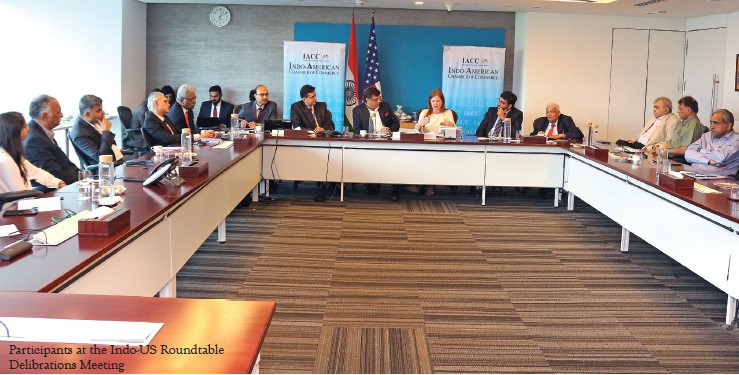
and textile materials could enter the US duty free. India was the largest beneficiary of the GSP programme in 2017 with $ 5.7 billion imports given duty free status. The GSP benefit conferred over the last three decades has significantly contributed to the growth of trade between India and US, and the participants felt that such mechanism should continue for enhancing trade between the two countries.
Regrettably, the preferential trade status for India under GSP was terminated, w.e.f. June 5, 2019. Participants argued that this retraction would negatively impact the Indian exports of goods to US which were earlier eligible for GSP benefit. The key products/industries that will be majorly impacted include dairy products, items of gold or silver, chemical products, engineering sector, and textile goods. Further, due to the increase in the duty rates for aluminium/steel, exporters in India have suffered a setback and the Indian Government raised a retaliation claim to recover the cost to the tune of $ 241 million approx. levied on steel/aluminium exports.
For the record, removal of GSP is likely to impact US companies as well. While it will cost American businesses over $ 300 million additional tariffs every year, the new tax will result in job losses, cancelled investments and cost increases for consumers. Furthermore, US companies will not get access to the Indian market.
It was suggested that new ventures should be identified for the same – for instance, the textile industry may evaluate setting up of processing units in US especially in areas like defence related textiles and clothing. This shall be a win-win situation for both the countries in a way that the basic raw materials such as yarn and fibre can be exported from India to US markets leading to value addition and employment in the US. Also, an external audit can be conducted of the Indian companies wanting to set up units in US, to certify or rate their strengths and capabilities. It was also felt that the two countries should collaborate and identify points of convergence to support the ‘Make in India’ initiative of the Government of India. Some areas where the convergence could be possible include agro processing, energy (both renewable and nonrenewable), infrastructure and defence.
Data localisation was another central point on the discussion table. The considerable growth in the payment ecosystem in India has warranted safety and security of technology dependent processes and workflows involved in the realm of the payment system. Key concerns included high cost of investment in in storage infrastructure in global servers in order to align with the RBI requirements; and cost of investment in security and monitoring systems for the local servers. There is also concern about third party risk, as payment data is processed and stored in multiple geographies. Therefore, organisations need to gain clarity on countries’ relevant data laws as applicable. Payment System Operators (PSOs) will also need to ensure compliance by third party service providers.
It was consequently suggested that PSOs should identify the flow of payments data in their payment process in order to align with the RBI requirements as applicable. Also, they should aim to segregate the storage mechanism for domestic payments from cross-border payments. Contractual arrangements and periodic assessments of the third party partners could be considered to ensure compliance of the service providers, intermediaries, payment gateways and third party vendors.
One of the ‘touchy’ points up on debate was the allocation of work visas for Indian nationals. It is now a well-known fact that acquiring work visas in the US has become increasingly difficult for Indians due to the ‘Buy America, Hire American’ diktat of US President Donald Trump and related policies leading to the hiring of highly skilled foreign nationals or highest-paid beneficiaries. There has also been a steady rise in H-1B denials and Requests for Evidence (RFEs) with regard to H-1B petitions and visas. Moreover, the US government is also considering a cap on H-1B visas issued each year to Indians at between 10-15% of the annual quota (there is no current country-specific limit on the 85,000 H-1B work visas granted each year, and an estimated 70% go to Indians). US Citizenship and Immigration Services (USCIS) has also reversed an order in which it selects H-1B petitions under the H-1B cap and the advanced US degree advantage. As a result of this change, there is nearly a 15% rise in the number of beneficiaries with a master’s degree or higher from a US institution of higher education being selected under the H-1B quota for FY2020. This has a negative impact on Indian headquartered companies with a large number of workers with US equivalent degrees but no US education.
As a result, millions of dollars are lost via project delays and contract penalties due to high number of RFEs, unpredictability and lack of enough H-1B visas. Also, a large number of man hours are spent to address RFEs and 221(g) notices issued by the US Embassy or multiple Consulates in India. This further slows down in the processing of applications, leading to project delays and losses.
As far as arbitration goes, it was suggested that Alternate Dispute Resolution (ADR), in co-operation with the US for all kinds of trade between the two countries needs to be institutionalised. This culture is already prevalent in US, and India is slowly waking up to it. It was felt that the IACC could play a pivotal role in facilitating this between the two countries by providing that valuable platform.
Leadership of affected companies from various sectors including textiles, foreign banks, technology companies, insurance, and manufacturing, deliberated grassroots-level issues they are facing due to these trade irritants between the two countries and potential solutions were discussed. Attendees at the roundtable deliberations included company Chairmen and CXO level officers. The convention was chaired by Naushad Panjwani, Regional Vice President, IACC; along with Hasnain Shroff, CA; and Jennifer Larson, Deputy Principal Officer, US Consulate General, Mumbai, representing the US Government.